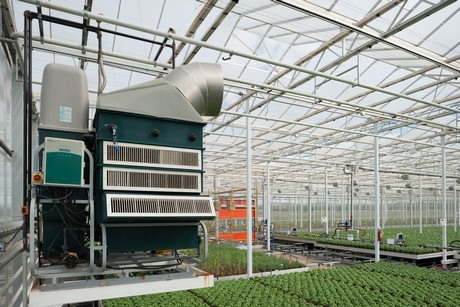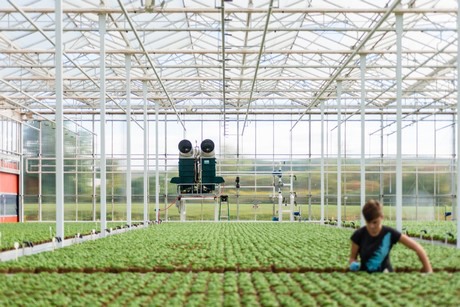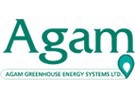Just thinking about dehumidification can make growers sweat. It can often be a vicious cycle in which they are wasting energy and encouraging the opposite of what they intended.
Here is the problem: Most growers have always been applying special (nighttime) venting strategies to reduce humidity and its accompanied risk for the growth of fungal spores. These spores establish themselves in water films on the leaves which are created when water vapor condenses on cool leaves and flowers at night. When venting, growers are exchanging humid inside air with dry drier, outside air. The colder outside air triggers heating, which in turn causes unnecessary nighttime transpiration. This results in more water vapor into the air and increases the humidity inside the growing environment again. This in turn leads to cooler plants, causing even more condensation and risk of diseases on the plants.

The Agam Ventilated Latent Heat Converter was developed to provide an alternative dehumidification strategy that at the same time would lower the disease pressure risk in controlled environments.
The heart of the system is a salt filter unit that absorbs humidity from the air and at the same time captures and neutralizes fungal spores like powdery mildew, botrytis and downy mildew. With the help of fans placed above the plant canopy, the Agam VLHC creates an airflow circuit that is continuously being treated by the unit: Humid air goes in; dry, de-humidified, filtered clean air comes out. This allows the grower to get rid of the humidity without having to open his vents and waste warm air.
The result is a more efficient, drier climate and less risk for diseases, while at the same time a lot of energy is being saved, as the vents can be kept closed at night.
According to Kurt Parbst of Envirotech, an increasing group of North American growers is interested in the system. The company started to work with Agam's VLHC three years ago and Parbst, who has a longstanding career in the horticultural industry, believes that it is one of the most exciting new innovations introduced to the market over the last couple of years.
"Humidity control is the largest frontier in terms of crop management and VLHC one of the most innovative technologies that our industry has seen over the last twenty years", he said.
Quality
Greenhouses are very dynamic spaces in which energy, humidity, and crop health are important pillars. The Agam unit is currently one of the few tools available that allows influencing all three of these aspects. Parbst said that growers are especially interested in the system not because of its energy saving aspects, but because it allows them to increase and optimize their production.
"For them it is more valuable to be able to produce healthy, high yielding or high quality plants and avoid crop loss due to fungal infections. The energy saving aspects moreover provide an easy way to calculate and support the investment."
As an example, Parbst spoke about situations where growers are losing sometimes 10 to 35% of their crops due to fungal diseases caused by excess humidity.
"A greenhouse grower is under constant threat of humidity," said Parbst. "Avoidance of crop loss due to humidity is top of mind for many growers. They know that they will start seeing diseases when it's getting dark and dense, it's always out there like a thief in the night. These are irreplaceable losses of high value crops which can be drastically reduced with the Agam. That is why growers who recognize quality and production as the most important part of their business are the early adopters of this system."

Over the last couple of years, Envirotech has installed the system at 30 to 40 growers throughout the United States and Canada. "Users are producers of high value crops like flowers, potted roses, herbs, especially basil, and cannabis, but the system can also be interesting for growers of more or less 'low value' crops like cucumbers, bell peppers and tomato, as they too struggle with humidity related threats to quality and yield."
Indoor grow operations
Parbst explained that while the greenhouse industry is the most interesting market for the system, they are also installing the system at indoor growing operations. "Operations that grow without daylight are losing their control of humidity as soon as they turn off their lights and the air conditioning switches off as the temperature target is satisfied. At that point the Agam system is a supplementary solution to handle the humidity and replace energy-inefficient dehumidifiers to control the humidity during the troublesome, dark hours."
Agam enhance their VLHC system with a special feature to provide cooling for situations when the greenhouse has a seasonal cooling need (summer nights). When growing indoors or in a tropical climate that require only dehumidification with cooling, like Hawaii or Southern Florida, the Agam Hybrid Air Conditioning (HAC) system provides a more efficient cooling solution to conventional air conditioning, while it also dehumidifies and filters the air and makes it free of spores, diseases and pathogens.
For more information (North America)
 EnviroTech
EnviroTech1275 Hall Ave Suite D
Richmond, CA 94804
(888) 459 8063
sales@envirotechcultivation.com
envirotechcultivation.com
For more information (Worldwide)
 Agam Greenhouse Energy Systems Ltd.
Agam Greenhouse Energy Systems Ltd.Chaim Edelman
chaim@agam-energy.com
Tel. +972-8-9403050
Fax.+972-8-9403232
www.agam-greenhouses.com
www.agam-energy.com
